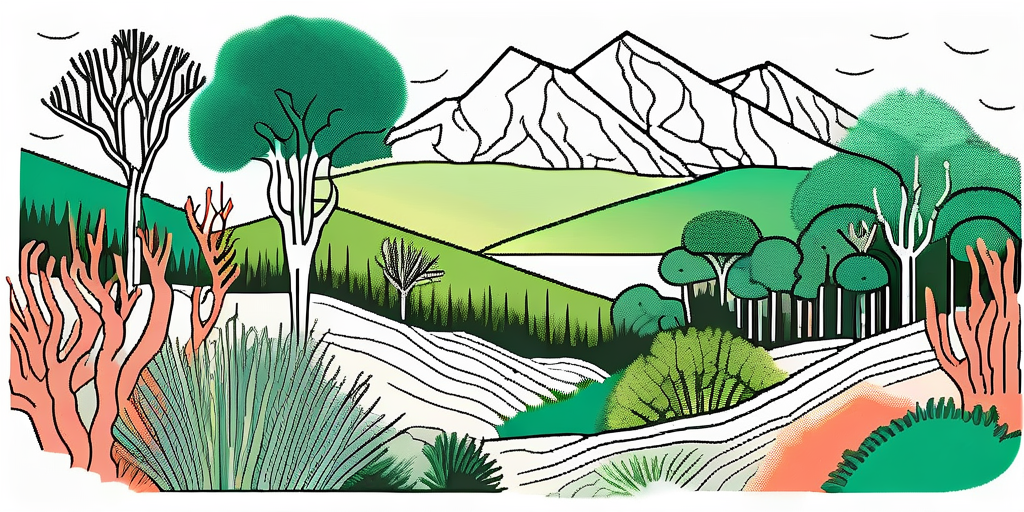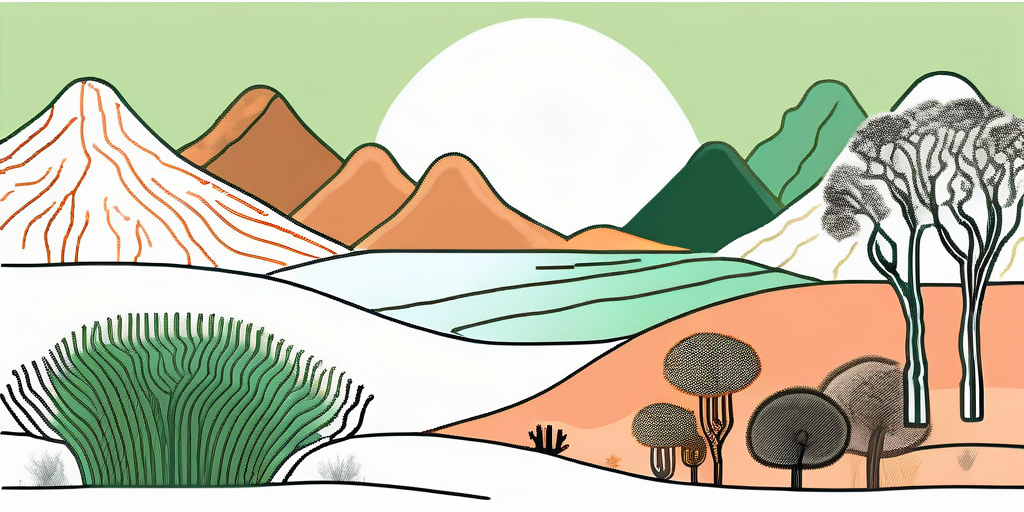what characteristics define biomes
In the vast tapestry of our planet’s diverse ecosystems, biomes stand as the defining units that shape and support life. From the towering rainforests to the vast stretches of deserts, each biome holds its own unique charm and significance. Understanding the characteristics that define biomes allows us to appreciate the intricate web of life that exists on Earth and inspires us to protect and conserve these invaluable ecosystems.
Understanding the Concept of Biomes
Before diving into the fascinating world of biomes, it is essential to grasp the fundamental concept behind them. Biomes, by definition, are large geographical regions with distinct climatic conditions and distinct patterns of plant and animal life. These regions are shaped by various factors, including temperature, precipitation, soil type, and topography.
Definition and Importance of Biomes
Biomes play a crucial role in maintaining the delicate balance of nature. They are vital for several reasons: preserving biodiversity, regulating the carbon cycle, and even influencing local and global climate patterns. These intricate systems not only provide habitats for countless species but also offer priceless resources and natural beauty for us to cherish and protect.
Different Types of Biomes
Our planet boasts a diverse array of biomes, each with its own distinct characteristics and allure. From the sprawling tundras of the Arctic to the sweltering savannahs of Africa, let us take a closer look at some of the awe-inspiring biomes our world hosts.
The Arctic tundra, with its vast expanse of frozen landscapes, is a biome that is both harsh and breathtakingly beautiful. This biome is characterized by extremely low temperatures, strong winds, and a short growing season. Despite these challenging conditions, the tundra is home to a remarkable variety of plant and animal species that have adapted to survive in this unforgiving environment. From the iconic polar bears to the resilient Arctic mosses, the tundra is a testament to the resilience and adaptability of life.
On the other side of the spectrum, we find the lush and vibrant rainforests, which are known for their unparalleled biodiversity. These biomes, found in tropical regions, receive abundant rainfall and are teeming with life. The rainforests are home to countless species of plants, insects, birds, and mammals, many of which are still undiscovered by scientists. The dense canopy, with its interwoven branches and vibrant foliage, creates a unique ecosystem where each organism plays a vital role in the intricate web of life.
Key Characteristics of Biomes
Exploring the key characteristics of biomes unravels the intricate tapestry of factors that shape these diverse ecosystems. Let us delve into the defining features that differentiate one biome from another.
Climate and Weather Patterns
The climate and weather patterns dictate the overall conditions of a particular biome. From the frozen realms of the polar ice caps to the humid tropics, the distribution of temperature, precipitation, and seasons shapes the plant and animal life that thrives within each unique biome.
Geographic Location
The geographic location of a biome provides further insight into its characteristics. The proximity to the equator or the presence of mountains, rivers, or coastlines all contribute to the distinctiveness of each biome. The location influences the availability of resources and even the movement of species across regions.
Plant and Animal Life
The remarkable diversity of plant and animal life within biomes holds a captivating allure. From the towering trees of the rainforests to the vast herds of the grasslands, the flora and fauna of a biome reflect the adaptability and resilience of life within specific conditions.
Let’s take a closer look at the rainforests, one of the most fascinating biomes on our planet. These lush and vibrant ecosystems are characterized by high levels of rainfall and year-round warmth. The dense canopies of the rainforest provide shelter to an astonishing array of plant species, from towering giants like the mighty kapok tree to delicate orchids that cling to the branches.
But it’s not just the plants that make rainforests so captivating. The animal life found within these biomes is equally diverse and awe-inspiring. From colorful birds with elaborate plumage to elusive mammals like jaguars and sloths, the rainforest is a haven for countless species. It is a constant symphony of sounds, with the calls of howler monkeys echoing through the trees and the melodious songs of tropical birds filling the air.
Now, let’s shift our focus to the grasslands, another remarkable biome that stretches across vast expanses of land. These open plains are characterized by a scarcity of trees and a dominance of grasses, which have adapted to withstand the harsh conditions of these environments. The grasslands are home to some of the most iconic animals on Earth, such as the majestic African lion and the swift pronghorn antelope.
In the grasslands, the relationship between plants and animals is intricately intertwined. Grazing herbivores rely on the abundance of grasses for sustenance, while predators like cheetahs and wolves depend on these herbivores for their survival. The grasslands are a constant battleground for survival, where speed, agility, and camouflage are essential traits for both predators and prey.
As we explore the various biomes that exist on our planet, we begin to appreciate the remarkable diversity and complexity of life. Each biome is a testament to the incredible adaptability of organisms and the delicate balance that exists within ecosystems. From the frozen tundra to the scorching deserts, biomes offer us a glimpse into the wonders of nature and the interconnectedness of all living things.
How Biomes Influence Ecosystems
Biomes serve as the foundational building blocks of ecosystems. Their influence extends beyond their immediate boundaries, creating ripple effects that shape the delicate balance of life on Earth.

When we delve deeper into the role of biomes, we discover a fascinating connection between these diverse habitats and the incredible biodiversity they support. The intricate interplay of plant and animal life within biomes contributes to the staggering biodiversity on our planet. Each species, however small or seemingly insignificant, plays an essential role in the intricate web of life, ensuring the stability and resilience of ecosystems.
Imagine a tropical rainforest biome, teeming with life. The dense canopy provides shelter for countless species of birds, mammals, reptiles, and insects. The vibrant colors of exotic flowers attract pollinators, while the towering trees provide nesting sites for primates and other arboreal creatures. In this biome, every organism, from the tiniest insect to the largest predator, has a specific niche and purpose. The delicate balance of predator-prey relationships and symbiotic interactions within this biome is a testament to the interconnectedness of all life forms.
Role of Biomes in Biodiversity
The intricate interplay of plant and animal life within biomes contributes to the staggering biodiversity on our planet. Each species, however small or seemingly insignificant, plays an essential role in the intricate web of life, ensuring the stability and resilience of ecosystems.
Let’s take a closer look at the grassland biome, for example. These vast expanses of open land are home to a diverse range of herbivores, such as zebras, antelopes, and bison. These herbivores, in turn, attract predators like lions, cheetahs, and wolves. The grasses themselves have evolved to withstand grazing and fire, creating a dynamic ecosystem that is constantly adapting and evolving. Without the presence of these herbivores, the grasslands would lose their balance, leading to a cascade of effects that would impact the entire ecosystem.
Biomes are not just a collection of different species; they are intricate tapestries of life, where every thread is essential for the overall picture to thrive. The interconnectedness of species within biomes highlights the importance of preserving and protecting these habitats, as the loss of even a single species can have far-reaching consequences.
Biomes and the Carbon Cycle
Biomes are intimately linked to the carbon cycle, a crucial process that regulates the Earth’s climate. Through photosynthesis, plants absorb carbon dioxide and release oxygen. The vast forests and grasslands of biomes act as vital carbon sinks, mitigating the impact of greenhouse gases and helping to regulate global temperatures.
Consider the dense forests of the temperate biome. These majestic woodlands not only provide a habitat for a diverse range of flora and fauna but also play a vital role in carbon sequestration. The towering trees, with their extensive root systems, absorb carbon dioxide from the atmosphere, storing it in their trunks, branches, and leaves. This process helps to reduce the concentration of greenhouse gases, mitigating the effects of climate change.
Furthermore, the intricate relationship between biomes and the carbon cycle extends to the world’s oceans. Marine biomes, such as coral reefs and kelp forests, are not only home to a myriad of marine species but also act as significant carbon sinks. The photosynthetic organisms in these biomes, such as coral polyps and kelp, absorb carbon dioxide from the water, playing a crucial role in maintaining the delicate balance of carbon in our oceans.
Understanding the intricate connection between biomes and the carbon cycle highlights the importance of preserving these habitats. By protecting and restoring biomes, we can ensure the continued regulation of global temperatures and the preservation of our planet’s delicate climate balance.
Human Impact on Biomes
Our actions as a species have profound consequences for the health and integrity of biomes worldwide. Recognizing the impact we have on these delicate ecosystems is the first step towards mitigating and reversing the damage we have caused.

Deforestation and Its Effects on Biomes
One of the most significant threats to biomes is deforestation. Ever-expanding human activities, driven by the need for resources, have led to the loss of vast tracts of forests. This destruction not only disrupts the delicate balance of ecosystems but also threatens countless species that rely on these habitats for survival.
Imagine a lush, vibrant rainforest teeming with life. The air is thick with the calls of exotic birds, and the ground is covered in a rich carpet of diverse plant species. This intricate web of life, however, is under constant threat from human activities. As trees are felled to make way for agriculture or to extract valuable timber, the once-thriving ecosystem is reduced to a barren wasteland. The loss of trees not only eliminates crucial habitats for countless species but also disrupts the water cycle, leading to soil erosion and decreased water quality. The consequences of deforestation ripple through the entire biome, affecting everything from climate regulation to nutrient cycling.
Climate Change and Biome Shifts
Climate change poses a significant threat to the stability of biomes worldwide. Rising temperatures, altered precipitation patterns, and changing weather conditions can cause biome shifts, pushing plants and animals beyond their natural ranges and disrupting the fragile harmony that has evolved over millennia.
Picture a vast, frozen tundra stretching as far as the eye can see. This seemingly inhospitable landscape is home to a unique array of cold-adapted species, from the majestic polar bear to the resilient Arctic fox. However, as global temperatures continue to rise due to human-induced climate change, the tundra is undergoing a dramatic transformation. The permafrost, which once provided a solid foundation for the delicate ecosystem, is thawing at an alarming rate. This thawing not only releases massive amounts of greenhouse gases into the atmosphere but also destabilizes the ground, causing sinkholes and landslides. As the tundra warms, new plant species are moving in, outcompeting the native flora and forever altering the delicate balance of the biome.
These examples of deforestation and climate change are just a glimpse into the myriad ways human activities impact biomes. From pollution to habitat fragmentation, our actions continue to shape the future of these vital ecosystems. It is crucial that we recognize the interconnectedness of all life and work towards sustainable practices that protect and restore the health of our biomes for generations to come.
Conservation of Biomes
In the face of rapid ecological change, conservation efforts become paramount. Appreciating the magnitude of the challenges we face inspires us to take action, preserving these extraordinary landscapes for generations to come.

Importance of Protecting Biomes
Protecting biomes is not simply an act of preserving natural beauty; it is a matter of safeguarding the very foundation of life on Earth. Biomes support biodiversity, regulate climate systems, and offer countless benefits to human well-being. By preserving these ecosystems, we ensure the longevity of our planet and the harmonious coexistence of all its inhabitants.
Imagine a world without the lush rainforests of the Amazon, teeming with an incredible array of plant and animal species. These biomes act as the lungs of the Earth, producing oxygen and absorbing carbon dioxide, thereby mitigating the impacts of climate change. Additionally, they provide vital resources such as timber, medicinal plants, and fresh water, which are essential for human survival.
Strategies for Biome Conservation
Conserving biomes demands collaborative efforts and a multifaceted approach. Strategies such as establishing protected areas, promoting sustainable land use practices, and educating communities about the value of biomes all contribute to safeguarding these precious ecosystems. By working together, we can ensure a future where biomes thrive, and the wonders of our planet continue to inspire generations to come.
One effective strategy is the establishment of protected areas, such as national parks and wildlife reserves. These designated areas serve as havens for biodiversity, allowing species to flourish undisturbed. They also provide opportunities for scientific research and ecotourism, raising awareness about the importance of biomes and generating funds for their conservation.
Another crucial aspect of biome conservation is promoting sustainable land use practices. This involves implementing responsible farming methods, such as agroforestry and organic agriculture, which minimize the use of harmful chemicals and preserve soil fertility. By adopting these practices, we can protect the delicate balance of biomes and ensure the long-term sustainability of food production.



